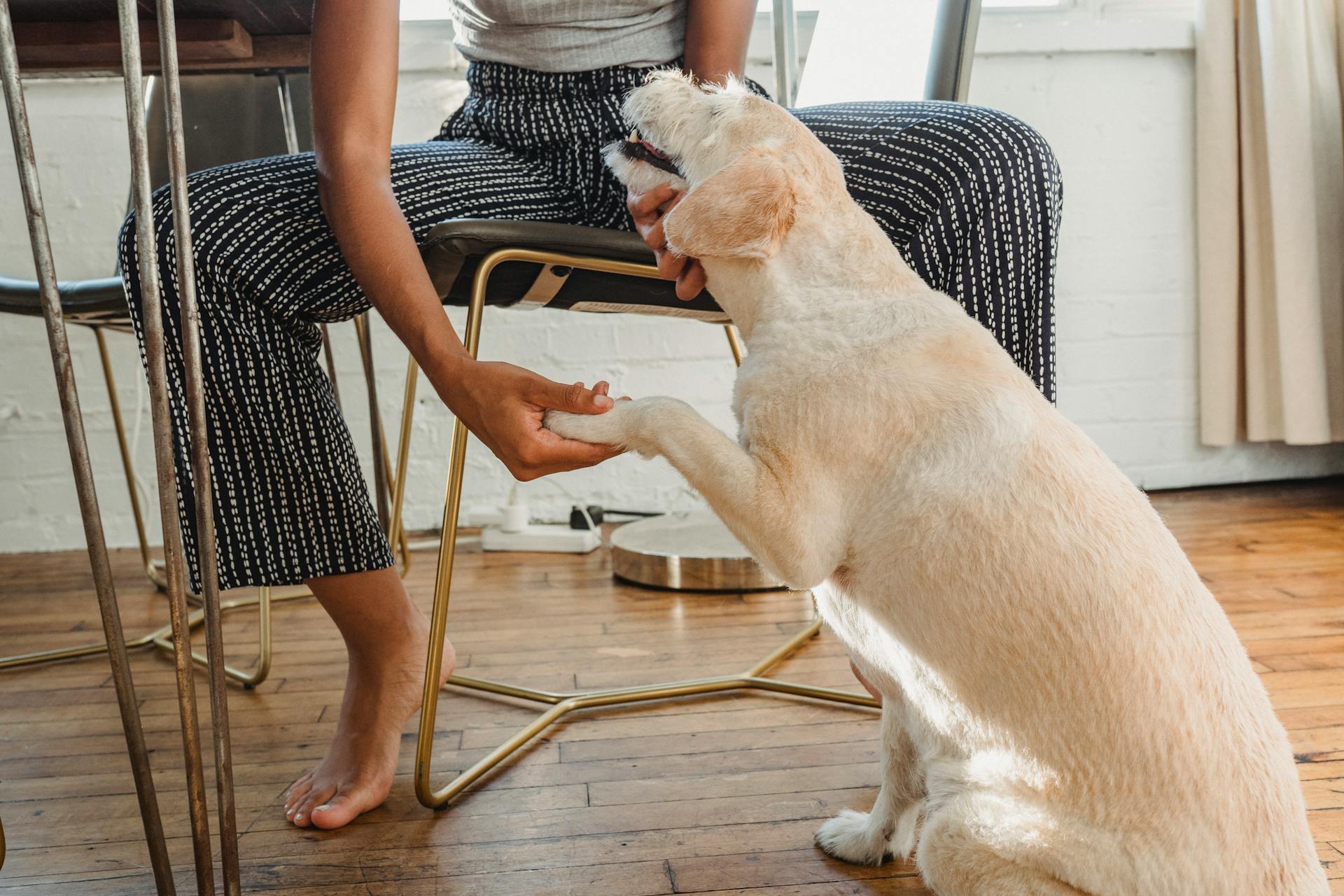
If your female dog is dragging her bottom, it can be a frustrating and painful issue for her. This behavior is often a sign of a medical problem, such as anal gland issues.
Anal gland problems are a common cause of dragging, as the anal glands can become impacted or infected, leading to discomfort and irritation. Impacted anal glands can cause your dog to drag her bottom, especially after bowel movements.
In addition to anal gland issues, other common causes of dragging include skin allergies, flea and tick infestations, and gastrointestinal problems. These conditions can cause your dog to scratch and lick her bottom, leading to irritation and discomfort.
If your dog is experiencing gastrointestinal problems, such as diarrhea or constipation, it can also lead to dragging. In such cases, the issue may be related to dietary changes or food allergies.
On a similar theme: Can a Bug Bite Cause a Lump on a Dog
What is Dog Scooting?
Dog scooting is a common behavior in dogs where they drag their butt across the floor to try to empty their anal glands. It can be caused by a variety of medical and behavioral issues.
If your dog is scooting, it's essential to take them to the veterinarian to rule out any medical problems. Once any medical issues have been addressed, you can work with your vet to develop a plan to prevent your dog from scooting.
Scooting is not necessarily a reason to be alarmed, but repetitive scooting could indicate a more serious issue that your veterinarian can help you diagnose and treat.
Here are some possible causes of your dog dragging her rear end along the floor:
- Fiber: A good, firm, bulky stool helps achieve the natural milking of secretion from the anal sac. Consider giving a fiber supplement if your dog's poop is excessively soft or has tiny nuggets.
- Avoid diarrhea: Producing runny stool doesn’t squeeze on the anal sacs, leading to discomfort and irritation.
- Anal sac issues: Some dogs are martyrs to anal sac issues, but there are ways to help.
- Allergies or parasites: These can cause irritation and discomfort, leading to scooting.
Causes and Treatment
If your female dog is dragging her bottom, there are several possible causes. Anal gland problems are a common culprit, with symptoms including scooting, not wanting to sit down, and a strong fishy odor near her rear end.
Anal gland issues can be painful and may require manual expression by a veterinarian, or in persistent cases, anti-inflammatory medication or even surgery. Don't try to express your dog's glands yourself, as this can cause more harm than good.
Other potential causes of scooting include allergies, intestinal parasites, and even referred back pain. If your dog is scooting regularly, it's a good idea to take her to the vet to rule out any underlying issues.
A food trial may be necessary to determine if a food allergy is the cause of the scooting. This involves feeding your dog a hypoallergenic diet for 8-12 weeks, with a single protein source and a single carbohydrate source that she hasn't eaten before.
Here are some common causes of scooting and their possible treatments:
- Anal gland problems: manual expression, anti-inflammatory medication, or surgery
- Allergies: hypoallergenic diet, corticosteroids, Atopica, or Apoquel
- Intestinal parasites: deworming medication
Possible Cause #2: Allergies
Allergies can be a sneaky culprit behind your dog's scooting behavior. If your dog's anal glands are fine, but they're still scooting, it's possible that an allergy is the cause.
Dogs with allergies often have itchy skin, and if they have a food allergy, the remains of that food passing out of their butt can inflame the mucus membrane and skin around the anus, leading to perianal irritation.
Curious to learn more? Check out: Female Dog Scooting

To treat allergies, you can try a hypoallergenic diet. This means finding a food that lacks the allergen and feeding it to your dog for 8-12 weeks to wait for the allergens to clear their system.
Here are some steps to follow:
- Feed a diet that contains a single protein source and a single carbohydrate source that your dog hasn't eaten before.
- Continue feeding this food and only this food for 8-12 weeks.
If your dog is experiencing severe skin inflammation, your vet may prescribe anti-inflammatory medication such as corticosteroids, Atopica, or Apoquel. These medications can help reduce inflammation and provide relief for your dog.
Parasites
Parasites are a common cause of scooting in dogs. Tapeworms, roundworms, whipworms, and hookworms can all contribute to this behavior.
Your dog might contract a parasite by sniffing or eating other animals' excrement, hunting rodents, or eating fleas that carry tapeworm larvae. This can lead to perianal irritation, causing your dog to scoot around in discomfort.
Some parasites, like tapeworms, can cause tiny white seed-like objects to appear near your dog's anus. If you suspect your dog has a parasite, it's essential to bring them to the veterinarian promptly.
Intriguing read: Dog Names Female Start with S
Parasites can be particularly dangerous in puppies, as they can cause serious health issues if left untreated. In older dogs, the consequences are often less severe, but worms can still cause problems by stealing their food and damaging the lining of their gut.
If your vet suspects a parasite, they'll likely do an examination, take a stool sample, or run a blood test to confirm the diagnosis. Deworming medication will then be prescribed to treat the issue.
For more insights, see: Can Eating Sticks Cause Diarrhea in Dogs
Natural Remedies and Prevention
If your female dog is dragging her bottom, it's likely due to anal gland issues or other underlying conditions. One of the main reasons dogs scoot is because of impacted anal glands, which can be caused by skin allergies and inflammation, anatomical problems, or chronic soft stool or diarrhea.
Adding fiber to your dog's diet can help prevent scooting. A good, firm, bulky stool helps milk secretion from the anal sac, so consider giving a fiber supplement or adding raw vegetables grated in their food, veggies to chew on, bran, or a fiber supplement in consultation with your vet.
A different take: Blood in Puppys Stool
Avoiding diarrhea is also crucial. Producing runny stool doesn't squeeze on the anal sacs, leading to discomfort and irritation. Be aware of this and aim to settle down that upset tummy as quickly as possible.
Manual expression of the anal sacs can also be a solution. However, this should be done by someone experienced in the correct way, such as a vet, vet tech, or groomer. Some dogs may need their anal sacs emptied every 2 weeks, depending on their anatomy and individual needs.
Here are some safe options for soothing your pup's butt at home:
- Fiber supplements or adding raw vegetables grated in their food
- Raw veggies to chew on
- Bran
- Manual expression by a vet, vet tech, or groomer
Symptoms and Issues
So, you've noticed your female dog dragging her bottom across the floor. This behavior can be quite concerning, but don't worry, it's often a sign of an underlying issue that can be easily treated.
Anal sac infections develop because of a blockage of the duct, leading to inflammation of the local tissues.
If your dog is scooting due to anal sac issues, it's essential to take her to the vet to rule out any medical problems. Once any medical issues have been addressed, you can work with your vet to develop a plan to prevent your dog from scooting.
Intriguing read: Bull Terrier Skin Problems
Skin irritation on a dog's bottom, like an allergic reaction to something, dermatitis, or a skin infection, is the second most common cause of dog scooting. Sometimes, it's a chicken vs. egg situation, where a pup might have problems with her anal sacs and develop a rash secondary to scooting, leading to a vicious cycle of licking/chewing/scooting and more irritation.
Some common causes of scooting include inflamed anal glands, skin irritation, and a dirty bottom. You can use warm compresses to soothe your dog's itch while you inspect to find the primary cause of her discomfort.
Here are some possible causes of scooting in dogs:
- Inflamed anal glands
- Skin irritation
- A dirty bottom
- Anal sac abscesses
- Allergies
- Parasites
Anal sac abscesses are a serious issue that can lead to bleeding and require immediate veterinary attention. If left unattended, an abscess can develop in the gland and rupture through the skin of the rectal region, causing bleeding.
If your dog is scooting on a regular basis, and her anal sacs need to be expressed every month or more, you may opt to have the sacs surgically removed. However, this is a serious decision that should be made in consultation with your vet, as there are significant risks attached, including fecal incontinence.
Frequently Asked Questions
When should I worry about dog scooting?
Worry about dog scooting if it persists for more than a few days, as it may indicate an underlying issue. Consult a vet for a rectal exam and faecal check to rule out anal gland problems or intestinal parasites.
What is the cure for scooting in a dog?
There is no single "cure" for scooting in dogs, but increasing fiber intake may help firm up stool and alleviate the issue in some cases. However, it's essential to consult a veterinarian to determine the underlying cause and develop a personalized solution.
Sources
- https://www.thewildest.com/dog-health/vet-advice-dog-scooting
- https://naturvet.com/blogs/tips-and-tricks/dog-scooting-101
- https://www.thefarmersdog.com/digest/dog-scooting/
- https://www.petsmont.com/blogs/pets/6-surprising-reasons-that-explain-dog-scooting-and-how-to-prevent-it-for-good
- https://www.petful.com/pet-health/dog-scooting-butt-across-floor/
Featured Images: pexels.com


